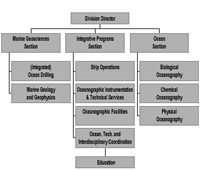 |
||
Division of Ocean Sciences Restructures to Meet Changing Needs
Ocean sciences are changing. The amount of international cooperation in research today is substantially greater than a decade ago. The number of special focused research programs, with their associated planning structures and steering committees, has increased dramatically. And both Congress and the Administration have demonstrated significant interest in ocean science, which has manifested itself in numerous interagency activities such as the National Oceanographic Partnership Program. To respond to the changes that have already occurred and to prepare for increased activity in the decades to come, the Division was recently restructured. Since 1981, the Division had been divided into two Sections: the Ocean Sciences Research Section, within which all the research programs resided; and the Oceanographic Centers and Facilities Section, which provided support for the Academic Research Vessel Fleet and the Ocean Drilling Program. The new structure for the Division arranges programs into logical groupings by research interests and functions (see Figure 1). It consists of the following three sections:
This new structure is expected to improve internal efficiencies and to allow for balanced growth across the Division. The addition of a new senior-level Section Head will allow management to give increased attention to strategic issues such as the development of the Integrated Ocean Drilling Program as well as the interagency long-range plan for the Academic Research Vessel Fleet and the interagency plan for U.S. integrated ocean observations. The restructuring will entail several changes in responsibilities. Mike Reeve, who recently became head of the former Oceanographic Centers and Facilities Section will serve as head of the Integrative Programs Section. Larry Clark, former Program Director of the Oceanographic Technology and Interdisciplinary Coordination program, was recently named as head of the Ocean Section. A search will be initiated for the new Section Head for the Marine Geosciences Section. In the meantime, Don Heinrichs (brought out of retirement temporarily to help with the transition process) will serve as Acting Section Head for MGS in addition to serving as Interim Division Director. The staffing at the Program level will not be affected by these changes, so community investigators are expected to experience no changes in their routine interactions with program staff. But this strengthening of the senior management of the Division will enable NSF to continue to play an increasing leadership role in ocean sciences research and education on both the national and international scenes. |
||
